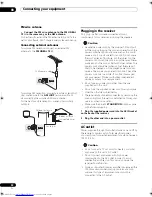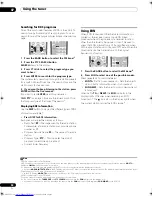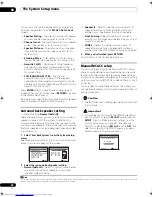
Listening to your system
05
30
En
Tip
• When an Advanced Surround listening mode is
selected, the effect level can be adjusted using the
EFFECT
parameter in
Setting the Audio options
on
page 70.
Listening in stereo
When you select
STEREO
, you will hear the source
through just the front left and right speakers (and
possibly your subwoofer depending on your speaker
settings). Dolby Digital, DTS and WMA9 Pro
multichannel sources are downmixed to stereo.
•
While listening to a source, press STEREO/F.S.SURR
for stereo playback.
Press repeatedly to switch between:
•
STEREO
– The audio is heard with your surround
settings and you can still use the Midnight,
Loudness, and Tone functions.
•
F.S.SURR FOCUS
– See
Using Front Stage Surround
Advance
below for more on this.
•
F.S.SURR WIDE
– See
Using Front Stage Surround
Advance
below for more on this.
Using Front Stage Surround Advance
The Front Stage Surround Advance function allows you to
create natural surround sound effects using just the front
speakers and the subwoofer.
•
While listening to a source, press STEREO/F.S.SURR
to select Front Stage Surround Advance modes.
•
STEREO
– See
Listening in stereo
above for more on
this.
•
F.S.SURR FOCUS
– Use to provide a rich surround
sound effect directed to the center of where the front
left and right speakers sound projection area
converges.
•
F.S.SURR WIDE
– Use to provide a surround sound
effect to a wider area than
FOCUS
mode.
1
Using Stream Direct
Use the Stream Direct modes when you want to hear the
truest possible reproduction of a source. All unnecessary
signal processing is bypassed, and you’re left with the
pure analog or digital sound source (see
Stream direct
with different input signal formats
on page 95).
1
While listening to a source, press S.DIRECT (AUTO
SURR/STREAM DIRECT) to select the mode you want.
Check the digital format indicators in the front panel
display to see how the source is being processed.
•
AUTO SURROUND
– See
Auto playback
on page 28.
•
DIRECT
– Sources are heard according to the
settings made in the Surround Setup (speaker
setting, channel level, speaker distance, acoustic
calibration EQ, and X-curve), as well as with dual
mono, the input attenuator, and any sound delay and
hi-bit/hi-sampling settings. You will hear sources
according to the number of channels in the signal.
•
PURE DIRECT
– Analog and PCM sources are heard
without any digital processing.
2
No sound is output
from the Speaker B in this mode.
SHIFT
STATUS
STATUS
MCACC
S.DIRECT
MULTI OPE
SIGNAL SEL
T.DISP
SBch
STEREO/
F.S.SURR
ADV. SURR
STANDARD
PHASE
THX
RECEIVER
PHOTO
SHIFT
STATUS
STATUS
MCACC
S.DIRECT
MULTI OPE
SIGNAL SEL
T.DISP
SBch
STEREO/
F.S.SURR
ADV. SURR
STANDARD
PHASE
THX
RECEIVER
PHOTO
Note
1 When using
F.S.SURR WIDE
, a better effect can be obtained if Auto MCACC Setup is performed. For more on this, refer to
Automatically setting up for
surround sound (MCACC & Full Band Phase Control)
on page 8.
2 There are cases where a brief noise is heard before playback of sources other than PCM. Please select
AUTO SURROUND
or
DIRECT
if this is a problem.
Front left
speaker
Front right
speaker
FOCUS
position (Recommend)
Front left
speaker
Front right
speaker
WIDE
position
SHIFT
STATUS
STATUS
MCACC
S.DIRECT
MULTI OPE
SIGNAL SEL
T.DISP
SBch
STEREO/
F.S.SURR
ADV. SURR
STANDARD
PHASE
THX
RECEIVER
PHOTO
VSX_LX60LX70.book Page 30 Wednesday, June 6, 2007 3:13 PM
















































